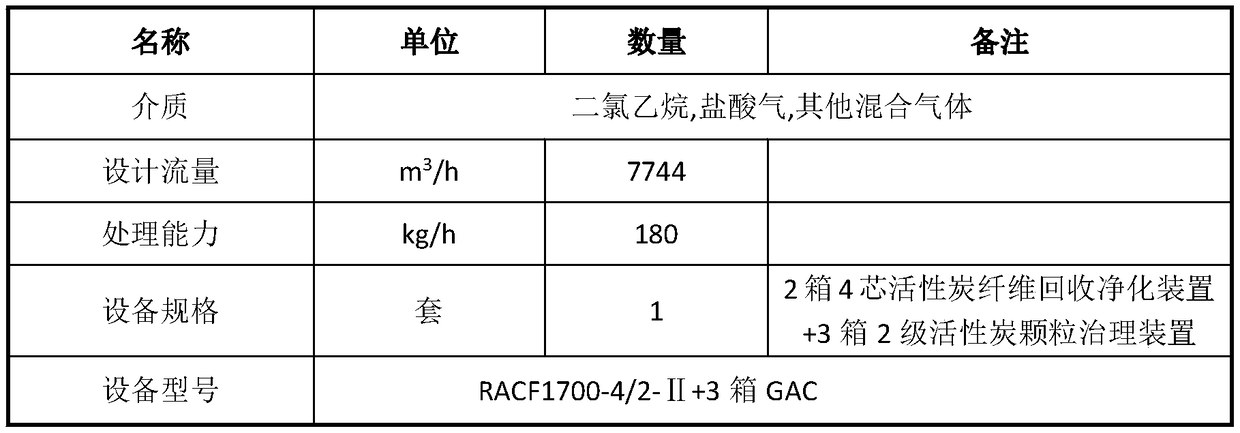Method for governing waste gas in 2-methyl-4-chlorophenoxyacetic acid workshop
A technology of dimethyltetrachloride workshop and treatment method, which is applied in the field of waste gas treatment of dimethyltetrachloride workshop, can solve the problems of short service life of carbon fiber adsorption and poor treatment effect, and achieve the effects of reducing pollution, saving resources and protecting the environment
- Summary
- Abstract
- Description
- Claims
- Application Information
AI Technical Summary
Problems solved by technology
Method used
Image
Examples
Embodiment 1
[0026] A method for controlling waste gas from a dimethyltetrachlorine workshop, characterized in that the treatment method comprises the following steps:
[0027] (1) Pass the waste gas to be treated into the alkali washing tower for alkali washing for 3 hours, and keep the pH in the tower to be 13 during this process;
[0028] (2) Pass the gas after alkali washing into the first-level water absorption tower, treat it for 8 hours, then pass through the mist eliminator to absorb excess water, and use the preprocessor to remove high boiling substances;
[0029] (3) Pressurize the gas processed in step (2), and then introduce it into the activated carbon adsorption box through the fan to complete the primary adsorption of the A adsorption box, the secondary adsorption of the B adsorption box, and the analysis and drying of the C adsorption box;
[0030] (4) Enter the condenser through the gas processed in step (3), fully condense into a liquid and enter the layered tank, the dic...
Embodiment 2
[0033] A method for controlling waste gas from a dimethyltetrachlorine workshop, characterized in that the treatment method comprises the following steps:
[0034] (1) Pass the exhaust gas to be treated into the alkali washing tower for alkali washing for 4 hours, and keep the pH in the tower to be 12 during this process;
[0035] (2) Pass the gas after alkali washing into the first-level water absorption tower, treat it for 7 hours, then pass through the mist eliminator to absorb excess water, and use the preprocessor to remove high boiling substances;
[0036] (3) Pressurize the gas processed in step (2), and then introduce it into the activated carbon adsorption box through the fan to complete the primary adsorption of the A adsorption box, the secondary adsorption of the B adsorption box, and the analysis and drying of the C adsorption box;
[0037] (4) Enter the condenser through the gas processed in step (3), fully condense into a liquid and enter the layered tank, the d...
Embodiment 3
[0040] A method for controlling waste gas from a dimethyltetrachlorine workshop, characterized in that the treatment method comprises the following steps:
[0041] (1) Pass the exhaust gas to be treated into the alkali washing tower for alkali washing for 3 hours, and keep the pH in the tower to be 11 during this process;
[0042] (2) Pass the gas after alkali washing into the first-level water absorption tower, treat it for 7 hours, then pass through the mist eliminator to absorb excess water, and use the preprocessor to remove high boiling substances;
[0043] (3) Pressurize the gas processed in step (2), and then introduce it into the activated carbon adsorption box through the fan to complete the primary adsorption of the A adsorption box, the secondary adsorption of the B adsorption box, and the analysis and drying of the C adsorption box;
[0044] (4) Enter the condenser through the gas processed in step (3), fully condense into a liquid and enter the layered tank, the d...
PUM
 Login to View More
Login to View More Abstract
Description
Claims
Application Information
 Login to View More
Login to View More - R&D
- Intellectual Property
- Life Sciences
- Materials
- Tech Scout
- Unparalleled Data Quality
- Higher Quality Content
- 60% Fewer Hallucinations
Browse by: Latest US Patents, China's latest patents, Technical Efficacy Thesaurus, Application Domain, Technology Topic, Popular Technical Reports.
© 2025 PatSnap. All rights reserved.Legal|Privacy policy|Modern Slavery Act Transparency Statement|Sitemap|About US| Contact US: help@patsnap.com



